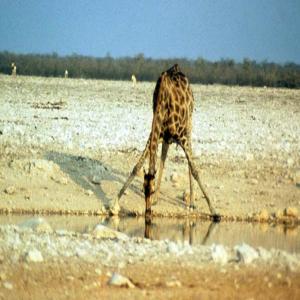
Dr. Steven Amstrup has been studying polar bears and their habitat since 1980, and much of what we know about them, and even how scientists study them, comes from his work. For instance, he was the first person to apply radio telemetry to the study of polar bears, which allowed scientists to understand the immense distances that polar bears travel, and that knowledge of their movements is vital to understanding polar bear ecology. He also developed studies to quantitatively describe denning habitat and developed the ability to locate dens under the snow with Forward Looking Infrared Imagery (FLIR). That allowed him to uncovered – quite literally – information about polar bear maternal denning. He made the unexpected discovery that over half of historic polar bear maternity dens in Alaska were on the drifting pack ice, and then, subsequently, he led work that showed that polar bears increasingly opted to den on land because of sea ice deterioration due to global warming.
Over the three decades he’s been studying polar bears, Amstrup has observed a profound change in their Arctic habitats and the threats they face, and he often speaks out about the need to mitigate greenhouse gasses if polar bears are to survive as a species.
Dr. Amstrup is currently senior scientist at Polar Bears International. He led the international team of researchers that prepared nine reports that became the basis for the decision, by the U.S. Secretary of the Interior in 2008, to list polar bears as a threatened species. He is a past chairman of the IUCN Polar Bear Specialist Group and has been an active member of the group throughout his career. Prior to joining Polar Bears International staff, he was the Polar Bear Project Leader with the United States Geological Survey at the Alaska Science Center, Anchorage, AK.
view more
More Episodes
The WildLife: Wildlife Law Enforcement in Alaska, Al Crane
 2010-01-25
2010-01-25
 193
193
 2010-01-25
2010-01-25
 193
193
The Wildlife: Creature Call Contest & Elephant Seal Update
 2010-01-18
2010-01-18
 132
132
 2010-01-18
2010-01-18
 132
132
The Wildlife: Whooping Cranes, Matt Mendenhall
 2010-01-04
2010-01-04
 26
26
 2010-01-04
2010-01-04
 26
26
The WildLife: Reindeer, Nancy Bazilchuk
 2009-12-29
2009-12-29
 30
30
 2009-12-29
2009-12-29
 30
30
The WildLife: Wildlife Crime & INTERPOL, David Higgins
 2009-12-21
2009-12-21
 145
145
 2009-12-21
2009-12-21
 145
145
The WildLife: Shark Fin Trade, Rebecca Regnery
 2009-12-15
2009-12-15
 47
47
 2009-12-15
2009-12-15
 47
47
The WildLife: Elephant Seals, Christine Heinrichs
 2009-12-09
2009-12-09
 51
51
 2009-12-09
2009-12-09
 51
51
01234567
Create your
podcast in
minutes
- Full-featured podcast site
- Unlimited storage and bandwidth
- Comprehensive podcast stats
- Distribute to Apple Podcasts, Spotify, and more
- Make money with your podcast
It is Free
- Privacy Policy
- Cookie Policy
- Terms of Use
- Consent Preferences
- Copyright © 2015-2024 Podbean.com





